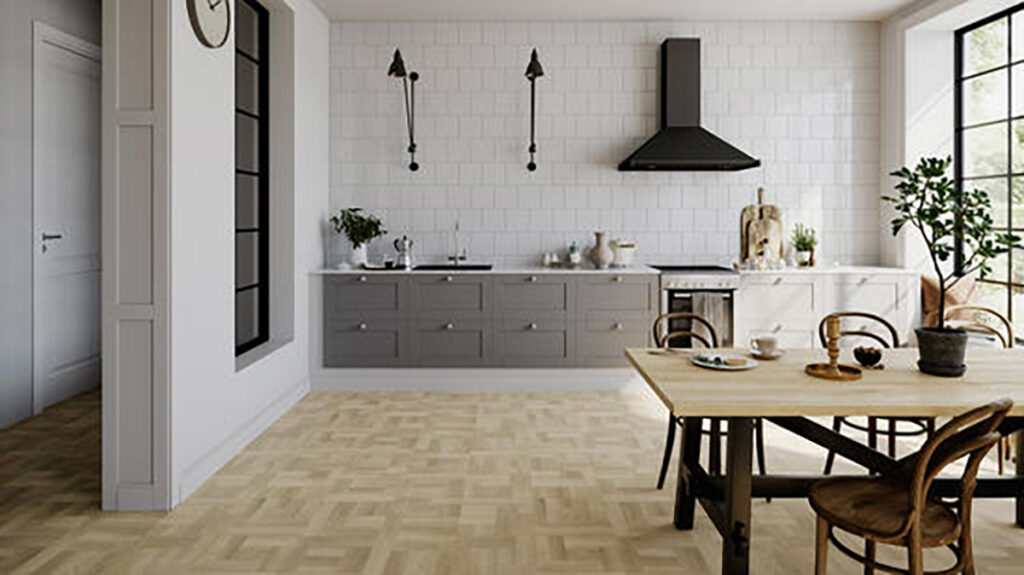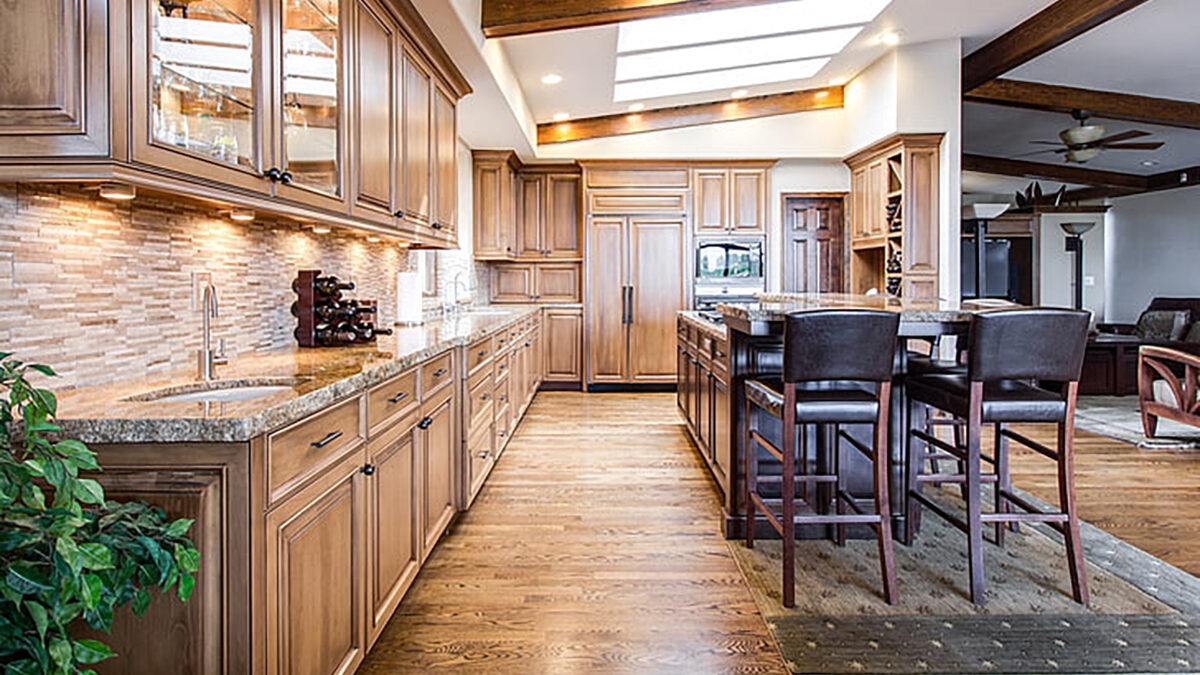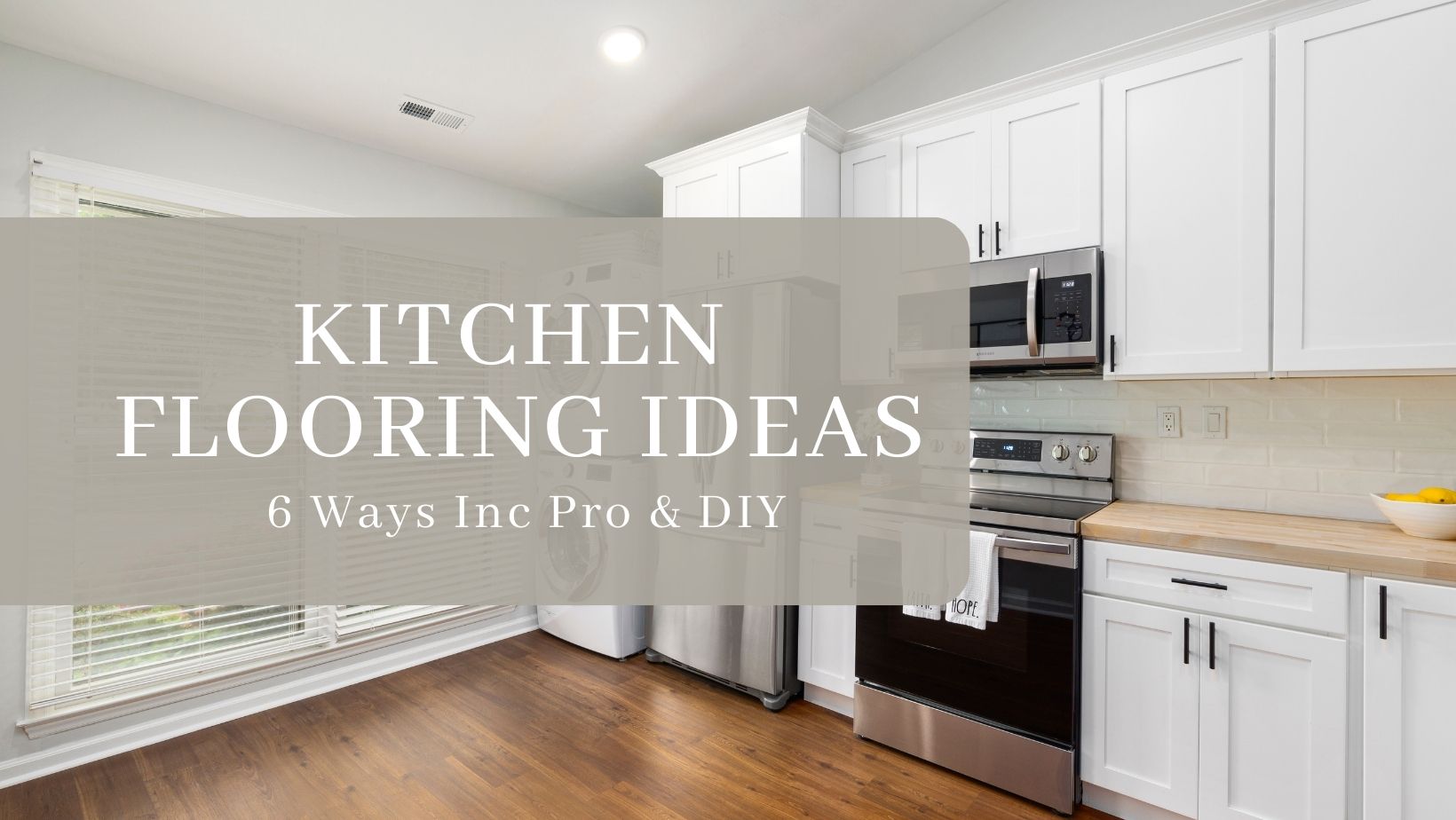Kitchen flooring is often the last thing to consider when planning or renovating your kitchen, yet, it sets the tone for the entire room and can make a big difference in terms of both form and function. With that in mind, let’s take a dive into all the popular options.
There are many types of kitchen flooring to choose from, including vinyl, laminate, waterproof materials, linoleum, wood and bamboo, concrete, ceramic tiles, and even cork.
Each has its own unique benefits and drawbacks that you’ll want to consider before making a final choice. In addition to these traditional options, there are also some newer materials such as epoxy flooring or anti-fatigue mats which may be worth exploring depending on your needs.
Vinyl Kitchen Flooring

Vinyl kitchen flooring is a great option for those looking for an easy-to-install and low-maintenance solution. It’s available in many different colors, styles, and textures so it can easily coordinate with any existing décor. Vinyl floors are also moisture-resistant and relatively inexpensive compared to other materials such as hardwood or stone. They also provide a degree of sound insulation which makes them an ideal choice if you live on the top floor of an apartment building. Plus they don’t require much upkeep – just sweeping, mopping, or vacuuming regularly should do the trick.
When it comes to vinyl kitchen flooring there are several different styles to choose from including sheet vinyl (single continuous sheets) tiles/planks (smaller pieces that fit together like puzzle pieces), or luxury vinyl tile/plank (a thicker version of regular plank). Sheet vinyl tends to be more affordable but may not offer the same level of customization as other options; however, planks and tiles give you more flexibility in terms of design since you can lay them out in patterns instead of solid colors. Luxury vinyl adds even more durability with its thicker layers making it perfect for areas prone to heavy foot traffic.
In addition to these traditional types there are also some newer designs such as click-lock vinyl that allow for DIY installation without using adhesives – this is especially helpful if you want a quick update without having to hire a professional installer! Whatever type you decide on make sure you read up on proper care instructions before starting your project so your new floor will last longer and look better over time.
Laminate Kitchen Flooring

Laminate kitchen flooring is an affordable and stylish option for many homeowners. It offers the look of hardwood or stone without the price tag or installation costs, making it a great choice for those on a budget. Laminate floors are also highly durable and resistant to scratches, stains and water damage so they’ll last longer than other types of flooring in busy kitchens.
Available in a wide range of colors, styles and textures laminate kitchen flooring can be customized to match any existing décor you may have while still providing the traditional look that comes with using wood or stone materials.
For DIYers there are several different styles of laminate kitchen flooring including click-lock planks that snap together like puzzle pieces; these require no adhesive whatsoever making them easier to install compared to other options such as ceramic tile which requires careful grouting work. There are also pre-glued planks available if you don’t mind some extra mess but want an even quicker installation process.
Finally, self-adhesive vinyl tiles provide a fast and easy solution often the choice for renters who want to spruce things up temporarily.
Wood and Bamboo Kitchen Flooring

When it comes to kitchen flooring, wood and bamboo are two of the most popular options for homeowners looking for a timeless and stylish look. Both materials offer several unique benefits when used in your kitchen including added warmth and natural beauty that will stand out from other types of floor coverings.
The main benefit of using hardwood or Bamboo as your kitchen flooring is the warmth and character they offer to a room, yet the downside is they are both susceptible to water damage and dints and scrapes from dropping heavy items. That said, the downsides are usually easily managed especially if spills are cleared promptly and care is taken.
Solid hardwoods come in various colors and styles so you can easily match them with any existing décor while providing maximum longevity – this makes them perfect for kitchens where long-term use is expected.
Engineered woods provide more stability than solids thanks to their multiple layers fused together; plus they’re often easier (and cheaper) to install since no sanding or staining is necessary before laying down each plank/tile.
Ceramic Tiles

Ceramic tile is a great choice for kitchen flooring as it provides superior durability with its dense material while also being easy to maintain. Its wide variety of colors and patterns make it possible to easily match any existing décor, plus ceramic tiles are fairly low cost compared to other materials such as hardwood or stone making them perfect for those on a budget!
When considering different styles of ceramic tiles for your kitchen flooring there are several options available on the market today including glazed, unglazed, quarry, and porcelain.
Glazed tiles have an extra layer that helps protect against dirt and stains; however, they tend to be more slippery than their unglazed counterparts so you may want to use non-slip mats in high-traffic areas if needed. Unglazed tiles provide added traction underfoot but require regular sealing every few years in order maintain their water resistance properties; this makes them great choices for kitchens prone to spills or humidity like around the sink or stovetop. Quarry tiles offer improved durability with thicker layers but come at higher price points – this type is often better suited as accent pieces rather than covering entire floors due to its limited design flexibility.
Finally, porcelain is one of the most popular types thanks to its superior strength/durability when compared with glaze/unglaze versions; plus there’s plenty of room for customization since many brands offer unique shapes and textures that can bring out your own personal style.
Cork Kitchen Flooring

Cork kitchen flooring is an increasingly popular option for those looking to add a unique and stylish touch to their space without sacrificing durability or comfort. This natural material has been used in homes since the 1800s and offers several advantages that make it ideal for busy kitchens – plus thanks to modern technology there’s now a wide range of colors and styles available on the market so you can easily match any existing décor!
The main advantage of using cork as your kitchen flooring is its ability to absorb sound which helps keep noise levels down in busy areas. Cork also provides superior insulation due to its cellular structure, making it perfect for spaces near the refrigerator or oven where temperatures tend to fluctuate throughout the day. Plus with proper maintenance this material can last decades without needing much work – all you need is occasional sweeping/mopping and reapplication of sealant every few years in order maintain its water resistance properties!
When considering different types of cork kitchen floorings there are two primary options: sheet and tile/plank (smaller pieces that fit together like puzzle pieces). Sheet cork usually comes pre-cut in various sizes so it’s easier (and cheaper) to install; however tiles/planks provide more flexibility when it comes design since they come in many different shapes, textures and colors. In addition some brands offer luxury vinyl tile/plank which adds even more durability thanks to thicker layers – these are great choices if you have kids running around often in your kitchen!
No matter what type of cork kitchen flooring you choose make sure you read up on proper care instructions before installation so your new floors will stay looking good over time!
Epoxy kitchen flooring

Epoxy kitchen flooring is quickly becoming a popular choice for homeowners looking to add style, durability, and easy maintenance to their space. This type of material provides several unique benefits that make it perfect for kitchens prone to spills or humidity like around the sink or stovetop – plus thanks to modern technology there’s now a wide range of colors and styles available on the market so you can easily match any existing décor!
The main advantage of using epoxy as your kitchen flooring is its superior strength/durability when compared with other materials such as hardwood or ceramic tile; plus since it’s applied in liquid form it offers more flexibility when covering areas with uneven surfaces. Additionally, this material is highly water-resistant which makes it great for areas prone to splashes/spills while also being relatively easy-to-clean (just sweep away dirt/dust and mop up messes). Lastly epoxy has excellent soundproofing qualities due to its thick layers – this helps keep noise levels down in busy kitchens making them more comfortable places for family gatherings!
When considering different types of epoxy kitchen floorings there are two primary options: self-leveling and poured systems. Self-leveling mixes come premeasured so they’re easier (and cheaper) for DIYers but require at least 24 hours drying time before being able to use the area again; however poured systems offer more customization since they allow you choose from various colors, textures and patterns based on individual needs. In addition some brands offer special non-slip finishes which provide added traction underfoot – these are great choices if you have kids running around often in your kitchen!
No matter what type of epoxy kitchen flooring you choose make sure you read up on proper care instructions beforehand so your new floors will last longer and look better over time!
DIY kitchen flooring options
DIY kitchen flooring can be a great way to save money while still achieving an attractive, functional space. One of the easiest types of flooring to install yourself is luxury vinyl plank (LVP) or tile (LVT). This type of material is made up of several thin layers that are coated with protective acrylics and come in a variety of colors and designs. LVP/LVT is highly durable, easy to clean, water-resistant, and soundproof which makes it well-suited for busy kitchens prone to spills or humidity around the sink or stovetop. Installation requires minimal tools and materials – just click together each piece like puzzle pieces until you’ve covered your entire floor!
Linoleum is another popular DIY kitchen flooring option since it’s relatively inexpensive compared with other materials plus there’s plenty room for customization since different brands offer unique shapes/textures. It provides superior insulation due to its cellular structure as well as excellent durability thanks to its thick layers – however keep in mind this material does require regular maintenance so make sure you read up on proper care instructions beforehand!
Finally, cork kitchen floors offer a unique style when compared with traditional hardwood/tile options; plus they provide superior comfort underfoot thanks to their naturally cushiony texture. Cork also offers improved insulation properties along with soundproof qualities making it perfect for busy kitchens – installation requires only basic tools but keep in mind this material may need occasional reapplication of sealant every few years depending on usage levels!
No matter what type of DIY kitchen flooring you choose make sure you do your research beforehand so you know exactly what supplies are needed and how long the process will take – then once everything has been installed correctly enjoy your beautiful new space!
Waterproof vs Water-resistant kitchen flooring
Alongside choosing the right material to suite your taste you’ll also want to consider the difference between water-resistant and waterproof. Waterproof and water-resistant kitchen flooring are designed to handle moisture to varying degrees. Here’s a breakdown of the two types, along with their pros and cons:
Waterproof Kitchen Flooring
Waterproof flooring is designed to prevent water from penetrating the surface, making it an ideal choice for kitchens where spills and splashes are common. Common waterproof materials include luxury vinyl planks (LVP), ceramic, and porcelain tiles.
Pros:
- Impervious to water: Waterproof flooring is completely impervious to water, meaning it won’t be damaged by spills or moisture.
- Easy to clean: Dirt and spills can be easily wiped off the surface, making it low-maintenance.
- Durable: Waterproof flooring is typically designed to withstand heavy foot traffic and wear, making it a long-lasting option.
- Comfortable: Some waterproof materials, such as LVP, provide a softer and warmer surface compared to traditional hard flooring options like tile.
- Style variety: Waterproof flooring is available in a wide range of colors, patterns, and textures, allowing you to choose a design that complements your kitchen’s aesthetic.
Cons:
- Cost: Waterproof flooring can be more expensive than water-resistant options, especially for high-quality materials.
- Susceptible to scratches: Some waterproof flooring options, such as LVP, can be prone to scratches and dents from heavy furniture or appliances.
- Installation complexity: Waterproof flooring may require professional installation, especially for tile options, which can add to the cost.
Water-resistant Kitchen Flooring
Water-resistant flooring is designed to handle small amounts of water exposure but is not completely impervious to moisture. Common water-resistant materials include laminate, engineered hardwood, and linoleum.
Pros:
- More budget-friendly: Water-resistant flooring options are often less expensive than their waterproof counterparts.
- Aesthetic appeal: Materials like engineered hardwood can provide an authentic wood look, while linoleum offers a variety of patterns and colors.
- Comfort: Water-resistant flooring is generally comfortable underfoot, and some options, like engineered hardwood and linoleum, provide a warmer surface than tile.
- Eco-friendly options: Some water-resistant materials, such as linoleum, are made from natural, renewable resources, making them more environmentally friendly.
Cons:
- Not completely waterproof: Water-resistant flooring can handle small amounts of moisture but may become damaged if exposed to large spills or standing water.
- Maintenance: Water-resistant flooring may require more frequent maintenance and care to avoid water damage.
- Durability: Some water-resistant flooring options, such as laminate, may not be as durable or long-lasting as waterproof materials.
In summary, waterproof kitchen flooring is an excellent choice for high-moisture environments and offers complete protection against water damage. On the other hand, water-resistant flooring is more budget-friendly and provides a more extensive range of aesthetic options but may require more maintenance and care to prevent water damage. Ultimately, the choice between waterproof and water-resistant flooring will depend on your budget, design preferences, and the specific needs of your kitchen.
Conclusion
When it comes to choosing the best kitchen flooring for your home, there are a lot of factors to consider. Not only does it have to look great and match your existing décor, but you’ll also want something that can stand up to regular wear-and-tear from family members, pets, and spills. Luckily there are plenty of options out there tailored specifically for kitchens so you can find the perfect choice that meets all of your needs!
Hardwood is one of the most popular choices in kitchen flooring due to its classic style and superior durability; plus with today’s newer models featuring extra layers of protection against moisture/stains they offer improved longevity when compared with traditional hardwoods. Ceramic tile is another excellent option since it provides an easy-to-clean surface area along with plenty room for customization (from various shapes/textures). Natural stone such as granite or marble bring unique style while offering superior strength plus they come in different colors/patterns making them ideal if you want something truly eye-catching!
Cork floors bring comfort underfoot thanks to their cushiony texture while providing insulation properties – this makes them great choices for busy kitchens prone to splashes/spills near the sink or stovetop. Luxury vinyl tiles/planks provide even more durability plus come in a wide range of colors so you can easily find something that matches any existing décor; epoxy floors offer special non-slip finishes which make them perfect if you have kids running around often in your space. Lastly anti-fatigue mats are designed specifically for those who spend long hours on their feet cooking – these provide added cushioning underfoot helping reduce joint strain over time!
No matter what type of kitchen flooring you choose make sure you read up on proper care instructions beforehand so it will stay looking good over time – then enjoy your beautiful new space!

